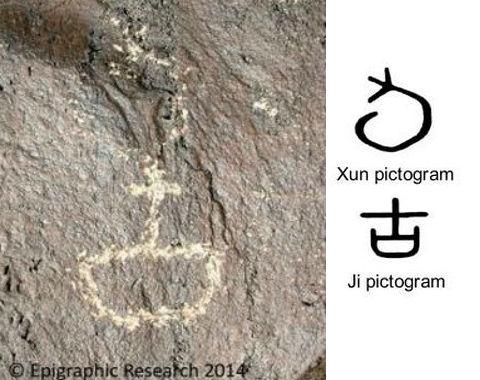It is commonly held that Native Americans are descended from people who traveled across the what is known today as the Bering Strait, between Siberia and Alaska, some 10,000 years ago. At the time, water levels were low and a land bridge emerged, connecting the continents. It is also commonly held that from the time of this crossing until about 1000 A.D. when the Vikings arrived, no expeditions brought explorers or colonists from the Old World to the New.
Yet some say that puzzling artifacts, as well as the results of recent DNA studies performed on Native Americans, may suggest contact between ancient China and North America.
John A. Ruskamp Jr. is a research analyst who has compared ancient Native American glyphs with ancient Chinese pictograms, finding what he says is a sure match between the two. The glyphs and pictograms date to a period long after the Bering Land Bridge crossing and long before modern contact between Chinese and Native American cultures. Geneticist Dr. Donald Yates has studied Native American DNA, finding what he believes may be genetic links to colonists from China’s ancient or medieval periods of history.
Yates hypothesizes that Native American genealogy is not as simple as commonly held. He says the ancestors of today’s Native Americans may not have come in a single migration. He thinks other boats may have landed on the shores of the New World, carrying explorers unknown to historians today.
MORE:
- Geneticist Traces Mysterious Origins of Native Americans to Middle East, Ancient Greece
- Anomalous Native American DNA: New Tests Show Middle East Origins?
We will briefly look at some of Ruskamp’s and Yates’s findings here.
Native American Glyphs Compared to Chinese Pictograms
Ruskamp has used the Jaccard Index of Similarity to compare Native American glyphs to Chinese pictograms. This index was developed by 19th century botanist Paul Jaccard and it is used to statistically compare similarity and diversity in sample sets. On his website, Ruskamp shows a list of 53 ancient Chinese pictogram-glyph pairings. Using the Jaccard Index, he calculated that in all 53 pairings, it is more than 95 percent likely that the glyphs match the pictograms. In other words, the chances that the glyphs formed independently—and that it’s just a coincidence they look like the pictograms—is less than 5 percent, according to Ruskamp. In most cases, it’s less than one percent.
A glyph found in New Mexico, for example, forms a traditional Chinese oracle-bone prognostication, wrote Ruskamp in an article on his website. The New Mexico glyph, if interpreted using the ancient Chinese pictograms, reads: “The next 10-day period will be auspicious.” Ruskamp has studied many more glyph-pictogram pairs than those in the list of 53 discussed here, and he continues his research.







